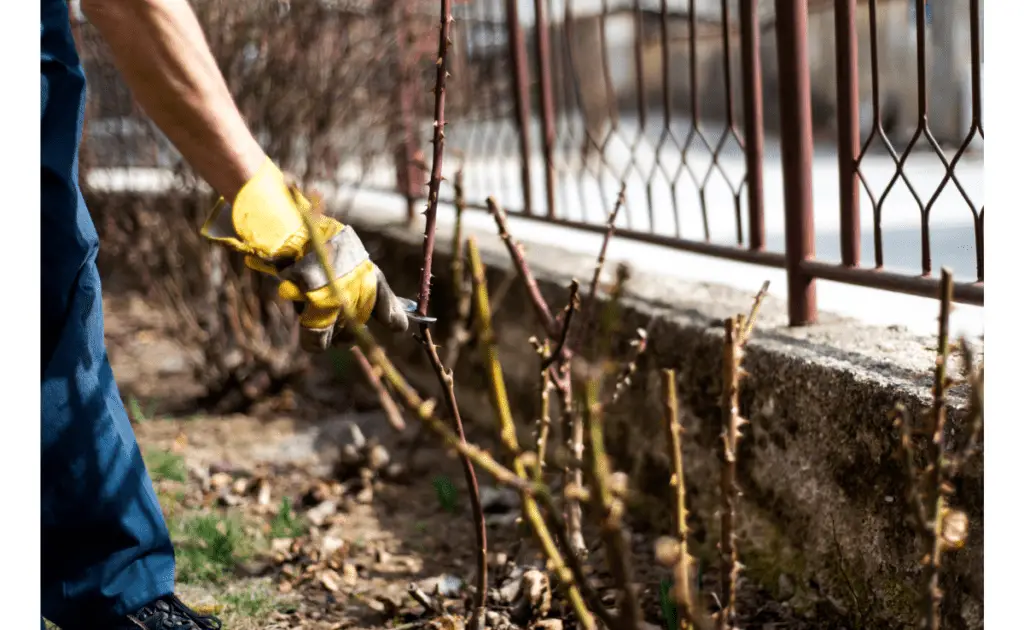
To prune roses remove all remaining leaves, cut dead wood off, remove cross branches and weak stems. Finally do a general clean up of the area. In this article, we’ll talk more about how to prune roses and other related information so keep on reading to learn more.
1. Remove All Remaining Leaves
This helps you see a structure of a bush and all the stems (canes). This process is also good for removing any diseases and pests that were hiding in foliage throughout winter.
2. Begin With Dead Wood
How to tell if it’s dead? Cut into it – green is living, brown is dead. Try cutting dead wood back to a base.
3. Open Up The Plant’s Center
Take out crossing branches that can rub, which usually cause damage as well as encourage disease. You need upward-reaching branches that have an open structure in the vase-like shape.
4. Remove Any Weak, Thin Growth And Then Prune The Remaining Canes
The basic rule here is to get rid of anything thinner than the pencil. Then you can continue pruning the remaining canes.
5. Seal Fresh Cuts
You can protect freshly cut canes from rose borers and rot by sealing them with a special compound used for such occasions.
6. Clean Up
After you are done with pruning, try cleaning up the surrounding area underneath. You need to dispose of all leaves and cut branches since diseases and pests can be lurking.
7. Feed The Roses
Roses are known to be “big eaters” and require proper nutrition, so don’t forget to feed them by using fertilizer.
When Should Roses Be Pruned?
The best time for pruning roses is in early spring or late winter. This could be as late as May or as early as January, depending on the climate. However, many people prefer pruning roses in winter since it’s the key time for cutting back most varieties, except the rambling roses, which should be pruned in summer right away after flowering.
What Happens If You Don’t Prune Roses?
Pruning sessions give you the chance to inspect each individual plant for weather damage, and also detect any possible diseases and pests.
1. Weather Damage
It’s worth inspecting rose bushes once the canes start showing signs of swelling in early spring or late winter. Taking a closer look at your rose garden can reveal any damage to the plants from the drought or winter’s cold. Dehydrated canes may seem shriveled, while diseased canes are usually black or soggy. Although broken stems don’t serve any purpose to the plant, they become detrimental since they can interfere with healthy new growth. Pruning to remove the offending canes will help your plants stay healthy.
2. Diseases And Pests
Lurking pests and diseases immediately attack neglected rose gardens because they are tempted by compromised and sickly plants. Fungal diseases like rust, blackspot, and powdery mildew find the moist and tangled bushes especially compromised, therefore, they become subject to weather and pest damage. Throughout the seasons, pests, diseases, as well as weather damage compound, which fuels the overall weakening of a rose garden. The long-neglected plants, particularly modern varieties like grandifloras and hybrid teas, may eventually die.
Where Do You Cut Back Roses?
Cut 1/4″ to 1/2″ above the outward-facing bud eye (the small bump where the leaf meets the stem). Keep in mind that new stems grow in a direction of a bud and a goal is to encourage stems to grow outward rather than inward. Make cuts at a forty-five-degree angle sloping away from a bud, which can allow water to run off.
Rose Pruning Additional Pruning Tips
Climbing Roses
Climbing roses have two types of canes, lateral and main. The lateral canes produce the flowers while the main canes come directly from a base. Pruning lateral canes can encourage blooming. And they can be pruned any time of the year for keeping them in shape.
Knock Out Roses Pruned
Pruning knock out roses is very similar to pruning climbing roses but with several exceptions. This type of rose is generally ready for its first pruning in the second or third season once it reaches the mature height of three-four feet. The timing of pruning is the same as most other roses; in early spring or late winter. Knock out roses tend to bloom on new growth, which means you should get rid of old, broken, or dead canes by cutting them back to a base.
These roses typically grow in phases – bloom – rest – bloom. If your roses need mid-season trimming, you should do it after the blooming period while the roses remain in the resting phase. Additionally, deadheading can also help in stimulating overall growth and new bloom clusters. Knock out roses usually produce many rose hips which inhibit flowering and trigger dormancy, so trimming hips off will keep roses blooming.
Rose Hips
If you live in an area with a warmer climate, you can leave rose hips on through the winter and fall; they tell roses it is time for dormancy. So rather than deadheading all the last blooms of a season, remove petals and allow rose hips to form. Roses naturally go dormant in cold climates, but in warmer climates, they need this nudge.
Pruning Height Trim Rose Bush
Prune to the desired height and keep a relatively consistent height throughout. If it’s in the back of the border, leave it just a little higher while for the front of the border, trim lower. When it comes to hybrid tea roses, pruning lower can make the flowers bigger and the stems longer. Leave them a bit taller and you’ll get more blooms, although on shorter and smaller stems.
As you can see, pruning is crucial to the health of your rose bush since it encourages flowering and helps prevent disease, pests, and any other damage by removing the areas which can harbor infestations. Even though the roses may look stark after pruning, they will grow prolifically and fill in quickly. So make sure to prune them when they need it and keep them healthy and beautiful.
Can I prune roses to the ground

Yes once a rose bush goes into dormancy the rose plant can be cut back to about 6 inches above the base. Prune roses only after the are done blooming or you will cut off your flowers for the season. Climbing roses can be pruned late season to help form a arch. We talk about how to prune above. Rose pruning can be just removing dead branches or complete cut backs. A rose bush is often grafted make sure not to cut back below the rose bush crown.
Pruning roses after they bloom | Prune rose plant after flowering
You can cut back roses after they bloom. Pruning roses after bloom also known as dead heading will help push the rose bush to produce more flowers.

This post contains affiliate links. If you make a purchase through these links, we may receive compensation at no additional cost to you.
